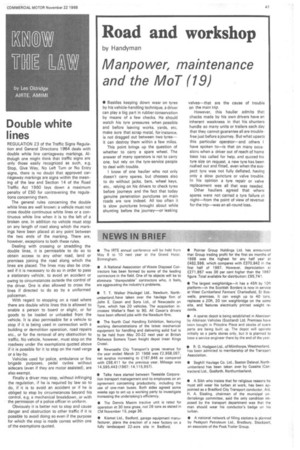Double white lines
Page 49

If you've noticed an error in this article please click here to report it so we can fix it.
REGULATION 23 of the Traffic Signs Regulation and General Directions 1R64 deals with double white line carriageway markings. AlthiSugh one might think that traffic signs are only those easily recognized as such, e.g. Stop, Give Way, No Left Turn or No Entry signs, there is no doubt that approved carriageway markings are signs within the meaning of the law and Section 14 of the Road Traffic Act 1960 lays down a maximum penalty of £50 for contravening the regulations concerning them.
The general rules concerning the double white lines are well known: a vehicle must not cross double continuous white lines or a continuous white line when it is to the left of a broken one. In addition no vehicle must stop on any length of road along which the markings have been placed at any point between the two ends of the marking. There are, however, exceptions to both these rules.
Dealing with crossing or straddling the double lines, it is permissible to do so to obtain access to any other road, land or premises joining the road along which the lines are placed. The lines may also be crossed if it is necessary to do so in order to pass a stationary vehicle, to avoid an accident or owing to circumstances outside the control of the driver. One is also allowed to cross the lines if directed to do so by a uniformed policeman.
With regard to stopping on a road where there are double white lines this is allowed to enable a person to board or alight, or for goods to be loaded or unloaded from the vehicle. It is also permissible for a vehicle to stop if it is being used in connection with a building or demolition operation, road repairs etc., or for the removal of any obstruction to traffic. No vehicle, however, must stop on the roadway under the exemptions quoted above if it is possible for it to stop on the road verge or a lay-by.
Vehicles used for police, ambulance or fire brigade purposes, pedal cycles without sidecars (even if they are motor assisted), are also exempt.
Finally a driver may stop, without infringing the regulation, if he is required by law so to do, if it is to avoid an accident or if he is obliged to stop by circumstances beyond his control, e.g. a mechanical breakdown, or with the permission of a police officer in uniform.
Obviously it is better not to stop and cause danger and obstruction to other traffic if it is possible to avoid doing so even if the purpose for which the stop is made comes within one of the exemptions quoted.




















































































































